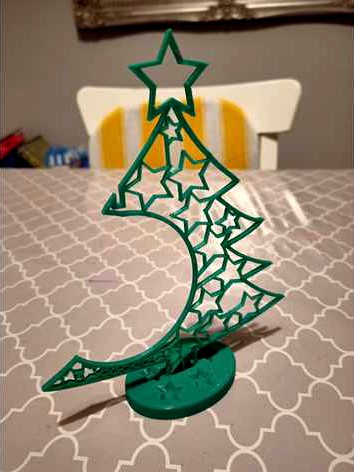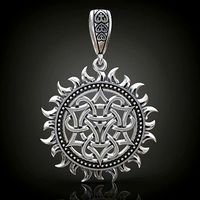Thingiverse

NarduganTree by afterdarq
by Thingiverse
Last crawled date: 3 years, 3 months ago
Nardoqan or Narduğan was celebrated by Turks on December 21, the longest night of the year and the night of the winter solstice. On this night, symbolizing old sun, becomes smaller as the days become shorter in the Northern Hemisphere, and dies on December 22, the winter solstice. It is said to be defeated by the dark and evil powers. On December 23 becomes the new sun.
While some scholars trace the origins of the Christmas tree to pagan rituals in pre-Christian England, others suggest the tradition was borrowed from ancient Germanic peoples. Now, however, veteran Turkish archaeologist Muazzez Ilmiye Çığ provides a new voice to the long-standing debate: The Turks were the ones who invented the Christmas tree
The Christmas tree, a brightly adorned symbol for Christians on one of their holiest days, also represents a link to the ancient Turks of Central Asia, according to a Turkish archaeologist.
Its origins are not in Norse myth or British isle paganism, as most Western historians believe, but in the Turkic tradition of the “wish-making tree.”
Europeans, Muazzez Ilmiye Çığ argues, adopted a rite to their own holiday ritual that stems from an old Turkish custom in which people decorated a special tree to offer their thanks to God.
“People put special things under a white pine as a present to God in response to his benefaction during the year,” said Çığ, adding that the custom first arose in Turkic Central Asia. “They also tied some pieces of cloth to its boughs to make a wish for the following year.”
While some scholars trace the origins of the Christmas tree to pagan rituals in pre-Christian England, others suggest the tradition was borrowed from ancient Germanic peoples. Now, however, veteran Turkish archaeologist Muazzez Ilmiye Çığ provides a new voice to the long-standing debate: The Turks were the ones who invented the Christmas tree
The Christmas tree, a brightly adorned symbol for Christians on one of their holiest days, also represents a link to the ancient Turks of Central Asia, according to a Turkish archaeologist.
Its origins are not in Norse myth or British isle paganism, as most Western historians believe, but in the Turkic tradition of the “wish-making tree.”
Europeans, Muazzez Ilmiye Çığ argues, adopted a rite to their own holiday ritual that stems from an old Turkish custom in which people decorated a special tree to offer their thanks to God.
“People put special things under a white pine as a present to God in response to his benefaction during the year,” said Çığ, adding that the custom first arose in Turkic Central Asia. “They also tied some pieces of cloth to its boughs to make a wish for the following year.”
Similar models
cg_trader
$12

Xmas Tree Keep Christ in Christmas | 3D
...used fir trees to decorate their temples at the festival of saturnalia. christians use it as a sign of everlasting life with god.
cg_trader
$6

Christmas tree | 3D
...eir temples at the festival of saturnalia, while ancient egyptians used green palm rushes as part of their worship of the god ra.
cg_trader
free

Christmas tree for the new year
... new year christmas winter celebration snow traditional fun tree snowman various models various models christmas tree winter tree
cg_trader
$25

Pagan Pendant sun nordic symbol | 3D
... trader
pagan pendant sun symbol, slavic or nordic ancient mysthical medalion. download 3d model for jewelry rapid prototyping
grabcad
free

acrylic christmas tree
...ovaks.
yule log traditions contributed to superstitions, as well as the traditions of gift giving and decorating the log or tree.
sketchfab
$5

Turkic Mausoleums_03
...- a burial vault for people of secular society. similar mausoleums are found among the turkic peoples of central...
cg_trader
$3

Wolf keychain | 3D
...medieval inner asia. wolf is the most important symbol of the all turkic people. this desing is the great gokturk khaganate flag.
cg_trader
$3

Designed Ottoman
... blocked all major land routes between asia and europe. western europeans had to find other ways to trade with the east.[1][2][3]
3d_export
$59

christmas tree
...mas tree decoration hohoho newyear holiday winter snow santa jesus christians happy peace wishes joy magic eid fiesta celebration
3d_export
$49

christmas tree
...mas tree decoration hohoho newyear holiday winter snow santa jesus christians happy peace wishes joy magic eid fiesta celebration
Afterdarq
thingiverse
free

G500 by afterdarq
...g500 by afterdarq
thingiverse
mercedes g500
thingiverse
free

NBA_Keychain by afterdarq
...nba_keychain by afterdarq
thingiverse
nba key chain
thingiverse
free

Honda_Keychain by afterdarq
...honda_keychain by afterdarq
thingiverse
print both then glue it back to back...
thingiverse
free

ORC_Bust by afterdarq
...orc_bust by afterdarq
thingiverse
little photogrometry work mixtured with meshmixer & blender...
enjoy it.
thingiverse
free

ManeskinKeyChain by afterdarq
...maneskinkeychain by afterdarq
thingiverse
i created this for my daughter & would like to share with you.
thingiverse
free

DesMerse-G500 by afterdarq
...desmerse-g500 by afterdarq
thingiverse
g500
hobby project
thingiverse
free

Tesla Keychain V1 by afterdarq
...tesla keychain v1 by afterdarq
thingiverse
this is just another tesla keychain version...
thingiverse
free

Tesla Keychain by afterdarq
...tesla keychain by afterdarq
thingiverse
double sided tesla key chain.
print two sides then glue it back to back.
thingiverse
free

Littlest Airliner by afterdarq
...q
thingiverse
just finished designing it, not yet printet... please be aware there will be some errors.
-rev1 wings are revised.
thingiverse
free

Doll's bed by afterdarq
...doll's bed by afterdarq
thingiverse
created it for my daughters. don't forget to re-scale it for your demand.
